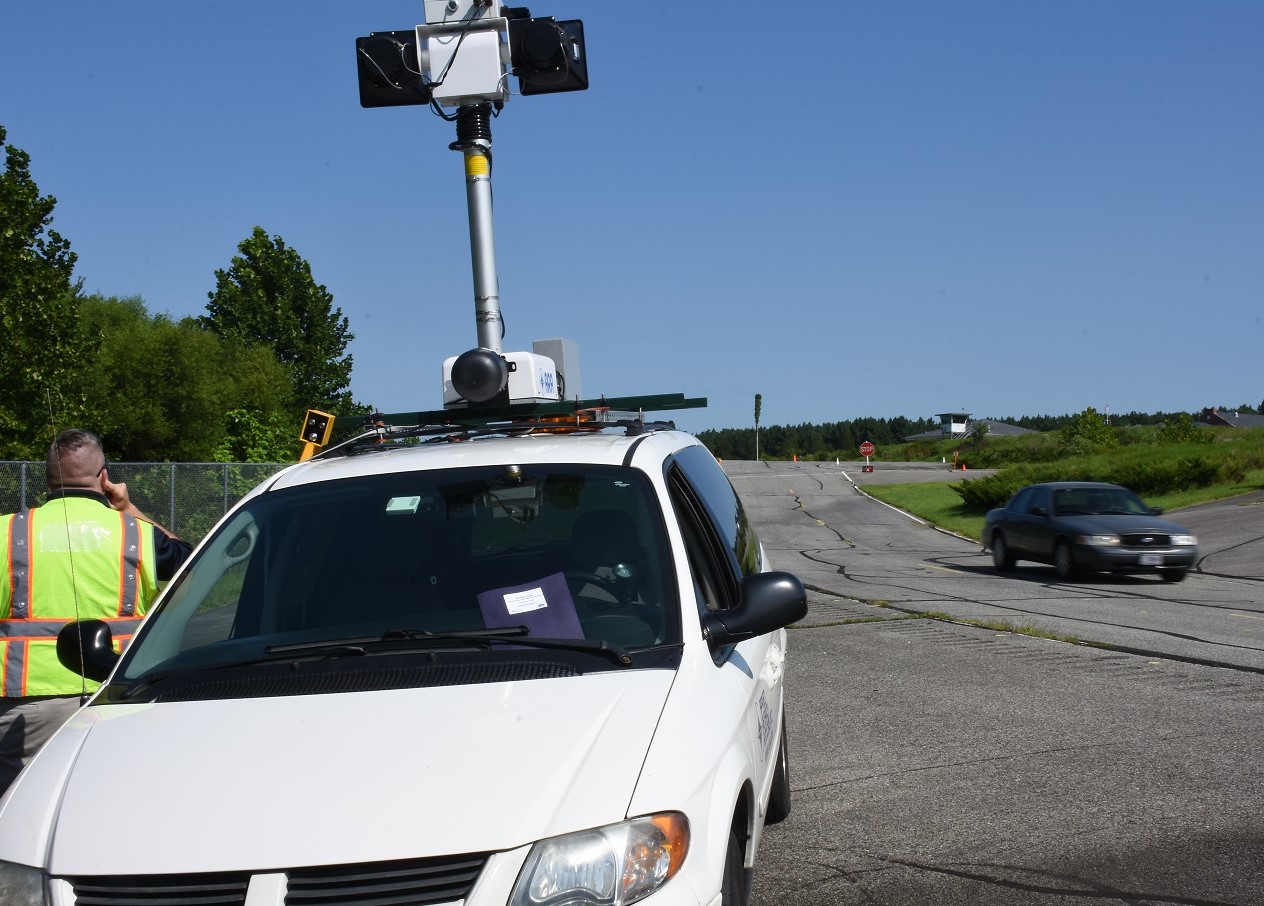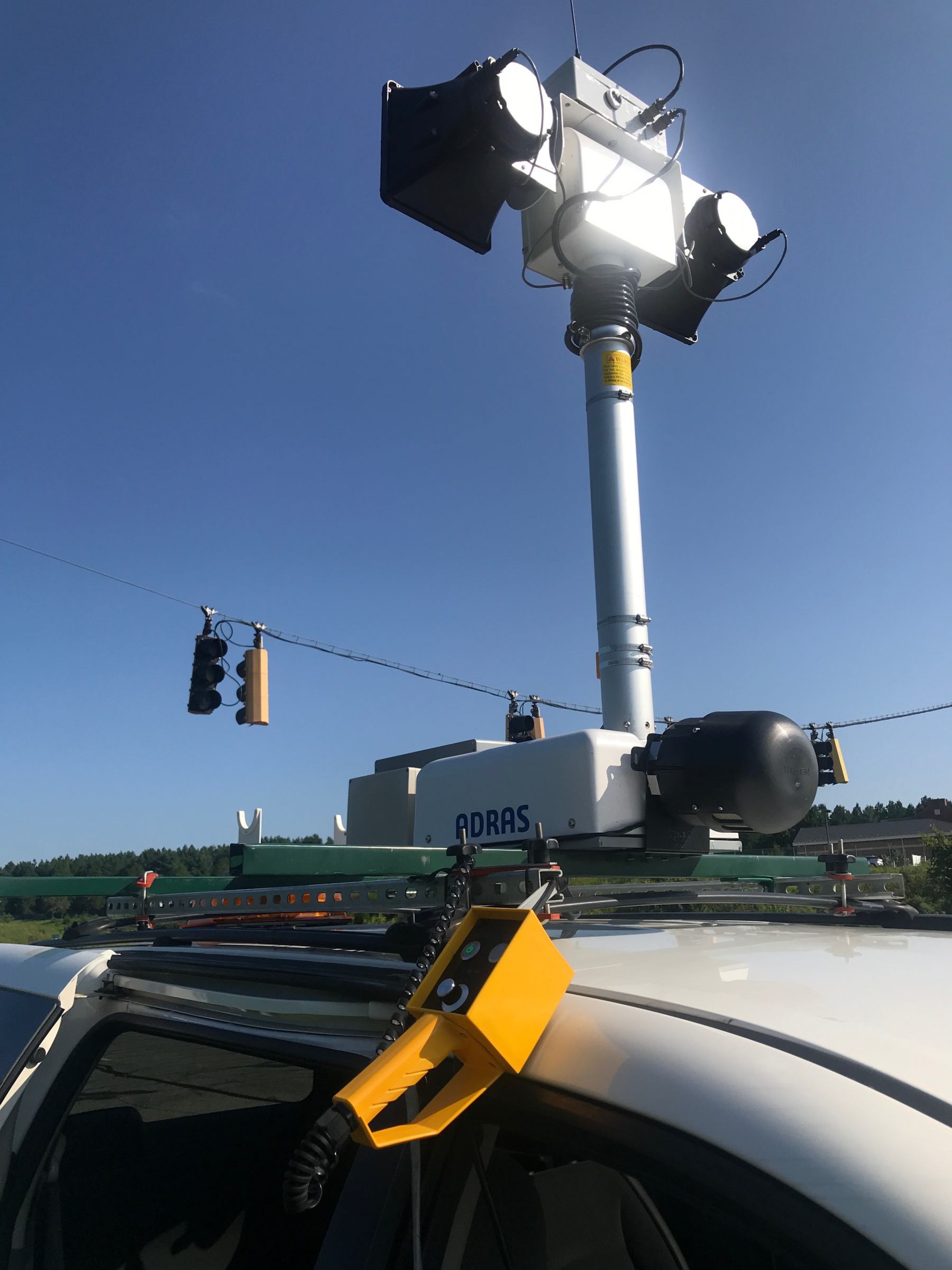
Distracted or impaired drivers. Speeding. Inclement weather. Whether at a traffic stop, a vehicle fire or a medical call, responders of all disciplines knowingly place themselves in harm’s way in service to commuters and communities. Every year, first responders are killed or severely injured when they are struck by vehicles that fail to slow down or avoid incident scenes.
The Automated Driver and Responder Alert System (ADRAS), a new technology funded by the Department of Homeland Security Science and Technology Directorate (S&T), aims to drastically reduce this risk.
ADRAS has two main components: a vehicle-mounted mast with loud speakers, a radar system, cameras and a siren; as well as an American National Standards Institute-standard safety vest equipped with light-emitting diode (LED) lights and small oscillatory motors. Once activated, the system’s radar detects the speed of oncoming vehicles and—at a miles-per-hour threshold set by the responders at the scene—triggers an audible alert. When vehicles do not heed the alert to slow down or move over, the vest illuminates, flashes and vibrates so the responders can escape harm. Once deployed, ADRAS also has the capability to record video of the incident scene, which may be useful in accident investigations.

S&T recently field-tested the technology with first responders at the Federal Law Enforcement Training Center in Cheltenham, Maryland, and their feedback is essential to ensuring the technology meets operational needs so responders can focus attention securely on the task at hand without being distracted by routine traffic.
“When I ride at night, that’s probably the most dangerous time to be an EMT because you have limited visibility… and because drivers don’t see you that well, I’ve come very close to getting hit,” said Margaret Fowke, volunteer emergency medical technician with the Silver Spring (Maryland) Fire Department. “When I found out about ADRAS, I thought ‘this is really going to be the answer.’ It has the potential to save a lot of lives.”
Developed by S&T commercial partner Applied Research Associates, Inc., ADRAS uses auditory cues, projected warning messages tailored by responders themselves, to warn approaching motorists to slow down. The system also employs visual and tactile cues to enhance responders’ presence and physically alert them to oncoming traffic. A heads up of just a few extra seconds to move over could mean a world of difference to those working at the side of the road and those behind the wheel.
“I’ve had a long career in law enforcement…and I can speak from personal experience that being on the side of the road at all hours of the night and in all road conditions is dangerous. I’ve been involved in some very close calls,” said J. David Smith, currently the chair of the Administration of Justice and Homeland Security Department at Salve Regina University in Newport, Rhode Island.

“Most nights you turn on the news and there’s another tragic case, either an officer, a firefighter, a tow truck driver, a Department of Transportation worker, or someone who’s been struck on the side of the road by a driver who was potentially distracted or under the influence of something, and it has to stop,” Smith continued. ADRAS’ tactile warnings, flashing lights and verbal alerts all contribute to necessary situational awareness. “Seconds count when you’re out on the side of the highway. As we saw with this technology, if you can provide that measure of safety with advanced warning, then that can be the difference between life and death,” he continued.
“We have all been on the road and driven by response vehicles at a traffic stop or tending to an accident scene and have witnessed the confusion and danger posed by these scenarios, both for the first responders and the traffic passing the incident,” said S&T’s Dr. Angela Ervin, ADRAS Program Manager. “Even if ADRAS alerts and warnings save just one life, the technology will be a complete success.”
In addition to the first responder evaluators, representatives from the U.S. Department of Justice, the Federal Highway Administration (FHWA), National Highway Traffic Safety Administration and Maryland Department of Transportation were on hand to observe and comment.
“As practitioner early in my career, I came close [to getting struck] myself,” said ADRAS evaluator James Austrich of FHWA. “I had the honor of evaluating ADRAS with other peers in the responder community, and it is a technology that could reduce what we call ‘struck by’ fatalities and injuries in the responder community. I see the system as a tool that could potentially save a lot of lives.”
Feedback from the operational field test, which featured simulated roadway incidents, will be posted to the S&T website, along with photos and video. The technology should be available to first responder agencies by spring 2019.
“We recently had a firefighter killed in Montgomery County in December 2017,” said Fowke. “He was off-duty and stopped to help an impaired vehicle that had crashed on the side wall. Even though he had lots of roadway and safety training, you can see how quickly someone can be injured or killed—so anything you can do to improve safety is great, and I think this is a great starting point for many first responders. I think this technology, especially the ADRAS safety vest, is light years ahead of what we’ve been doing.”

